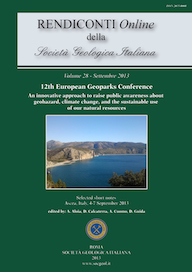
Discharge-electrical conductivity relationship in the Ciciriello Torrent, a reference catchment of the Cilento, Vallo Diano and Alburni European Geopark (Southern Italy)
A. Cuomo (*) & D. Guida (*)
(*) Department of Civil Engineering, University of Salerno, Via Ponte Don Melillo, Fisciano, Italy. E-mail: acuomo@unisa.it
Volume: 28/2013
Pages: 36-40
Abstract
Hydro-geomorphology is the key to link hydrology, hydraulics and ecological approaches in the European Water Framework Directive (hereafter, EWF) applications and management at local and regional level. The hydro-geomorphological response of a catchment to rainfall results by complex interactions between physical, biological and human processes, operating in the drainage basin system at different spatial and temporal scales. In 2012, a multidisciplinary and inter-institutional program on the relation between geodiversity and ecosystem functioning in the Cilento National Park (Southern Italy) was promoted by the Salerno University, granted by the Cilento, Vallo Diano and Alburni European and Global Geopark and supported by the Southern Campania Region Basin Authority. Within this program, a specific hydro-geomorphological monitoring project started on small, forested, headwater catchments. This paper presents the results of the preliminary analysis on streamflow and chemo-physical data acquired in the Ciciriello torrent (3,2 km2), considered as reference catchment for the small, forested, arenaceous and Mediterranean catchments of the Cilento, Vallo Diano and Alburni European and Global Geopark. The daily inter-storm and hourly storm time series analysis was used to establish relations between discharge and specific electrical conductivity to check origin, path and timing of the different runoff components. The time-space evolution of the Q-EC power relationship, recorded from different river sections, allowed to detect highest end member in the perennial spring flow water, lowest end member in stormflow water from impervious surfaces and quick return flow from saturated soils. Intermediate values can be referred to the delayed return runoff component from sub-soil and regolith.
Keywords
Cilento, hydro-geomorphology, discharge-electrical conductivity relationship, runoff component separation, Vallo Diano and Alburni European Geopark
Get Full Text